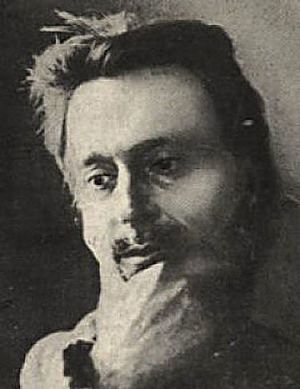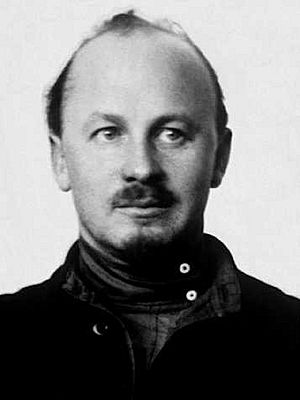Lev Chernyi facts for kids
Quick facts for kids
Lev Chernyi
|
|
|---|---|
| Лев Чёрный | |
 |
|
| Born |
Pavel Dimitrievich Turchaninov
Birth date unknown |
| Died | September 21, 1921 |
| Nationality | Russian |
| Occupation | Poet, activist |
| Known for | Revolutionary anarchism |
Lev Chernyi (born Pavel Dimitrievich Turchaninov; died September 21, 1921) was a Russian writer, activist, and poet. He was a key figure in the anarchist movement during the Third Russian Revolution.
In 1917, Chernyi was freed from prison by the Russian government. He quickly became one of the most important leaders in Russian anarchism. He spoke out against the new Bolshevik government in many anarchist writings. He also joined several secret resistance groups. Chernyi was arrested by the Cheka (the Soviet secret police) and was executed in 1921 without a trial.
Contents
Early Life and Ideas
Lev Chernyi was born Pavel Dimitrievich Turchaninov. His father was an army colonel. Chernyi was a smart thinker who wanted to change the traditional values of Russian society. He did not agree with the idea of voluntary communities, which were supported by some anarchists like Peter Kropotkin. Chernyi believed these communities could limit a person's freedom.
He wrote a book in 1907 called Associational Anarchism. In this book, he suggested a society where independent people could freely work together. Experts believe his ideas were greatly influenced by other individualist anarchists like Max Stirner and Benjamin Tucker. After his book was published, Chernyi was sent to prison in Siberia. This was because of his revolutionary activities against the Russian government at the time.
Return to Moscow and Opposition
When Chernyi returned from Siberia in 1917, he became very popular. He gave many lectures to workers in Moscow. At this time, he was one of Russia's top individualist anarchists. He was also a main thinker for the anarchist movement.
Chernyi was the Secretary and a leading thinker for the Moscow Federation of Anarchist Groups. This group was formed in March 1917 after Tsar Nicholas II of Russia stepped down from power. The group mainly focused on sharing their ideas with the poorer people of Moscow.
Chernyi knew some important Bolshevik leaders. However, he strongly criticized the new Russian Soviet Republic. At a meeting on March 5, 1918, he said that the socialist state was just as bad as the old government. He promised to "paralyze the governmental mechanism," meaning he wanted to stop the government from working.
Chernyi strongly supported taking over private homes. He wrote against the state in Anarkhiia, an anarchist newspaper. He suggested ways to organize production without a central government. In the spring of 1918, anarchist groups in Moscow formed armed groups called the Black Guards. These groups were created because the government was increasingly stopping people from resisting or speaking freely. The Black Guards were an early version of the Black Army, which later fought against the Bolsheviks in the Russian Civil War.
On April 11, 1918, the Cheka (the Soviet secret police) raided the House of Anarchy. This building was used by the Moscow Federation. The official reason was to arrest "robber bands" among the anarchists. However, the Black Guards fought back. About forty anarchists were killed or hurt, and around five hundred were put in prison.
Arrest and Execution
In 1918, Chernyi helped create a secret group. The next year, he joined another group called the Underground Anarchists. This group published a newspaper that strongly criticized the Communist government. They called it the worst kind of rule in history.
On September 25, 1919, the Underground Anarchists and some other revolutionaries bombed the headquarters of the Communist Party in Moscow. This happened during a meeting. Twelve Communists were killed, and fifty-five others were injured. Among the injured was a famous Bolshevik writer named Nikolai Bukharin.

Chernyi was arrested along with Fanya Baron. The official charge was making fake money. In August 1921, a Moscow newspaper announced that ten "anarchist bandits," including Chernyi, had been shot without a trial. However, a historian named Paul Avrich believes Chernyi was executed in September of that year.
Even though Chernyi was not directly involved in the bombing, he was connected to the Underground Anarchists. This made him a likely target for false accusations. The government did not give his body to his family for burial. Rumors spread that he had died from torture.
See also
 In Spanish: Lev Chorni para niños
In Spanish: Lev Chorni para niños
- Individualist anarchism in Europe
- List of anarchist poets
- One of the people who visited his lectures was Gerard Shelley
Images for kids



